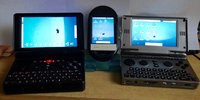Two interessting facts in one tweet. First, maximum cpu frequency(full speed) is now 1 Ghz and not 1.5 Ghz.
Who says that? We have it limited right now as we're working on the 4GB RAM. While 1.5GHz has been tested (hns even ran it at 1.7Ghz), it's safer for debugging the 4GB RAM issue to keep it at a speed which is known to work 100% stable.
Once the memory has been optimized as good as possible, the limit will be removed.
CPU speed and memory influence each other on the PCB here, so if it's set to 1.5GHz and something freezes, it could both be the memory or the CPU.
With 1GHz, we know for sure it's the memory, which makes debugging a LOT easier.
No one said anything about a final 1GHz speed (except yourself)
Second, without heatsink it is not possible to operate at full cpu load even at 1 Ghz, because thermal throtteling will kick in.
Says who?
The throttle speed is currently set at 120C, and wd didn't even get close to that.
But yes, at some time, the CPU needs to throttle, same as your smartphone CPU or any other modern ARM SoCs.
They're designed to run with incredible speed - but only for a short period of time. They will start to throttle if you do that for a few minutes.
This gives the advantage that you can have short peaks of high CPU usage (i.e. rendering a website is a lot faster).
But they NEVER will work without throttling (or active cooling) at full power for a longer periods of time.
The Pyra is no miracle, so yes, it is also bound by physics as any other device out there.
Summarized, a propper heatsink has to be developed, tested and produced wich means additional 6 month.
You are aware that this heatsink has been installed today (which was the reason for the tweet) and there's not really.much to test there? If it cools the CPU, it works.
So not sure why you're trying to troll here... But afair, you've done that a few times here already.
EDIT: Small correction: I browsed through all your posts and you never did anything else




